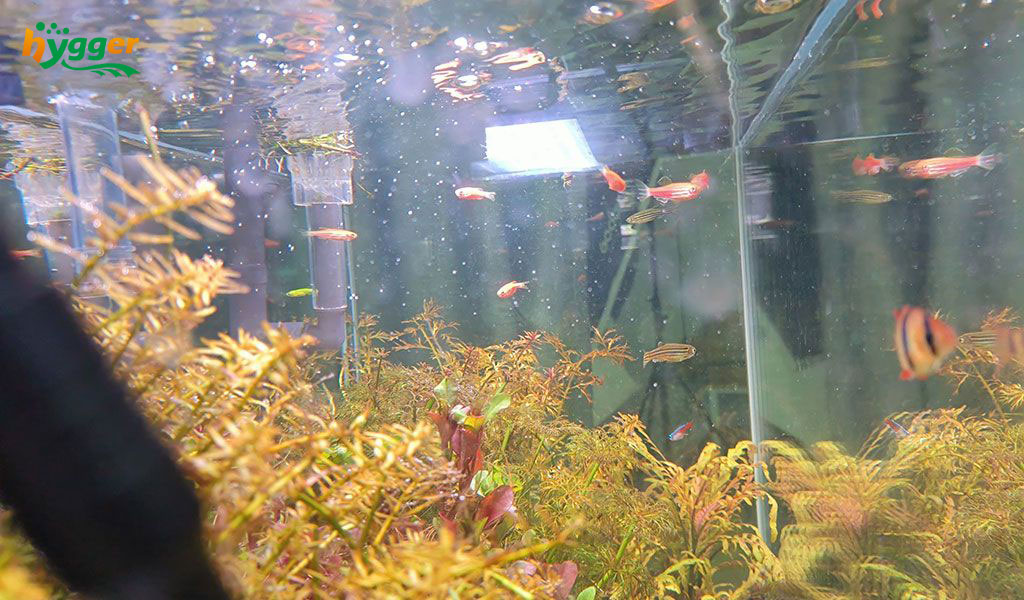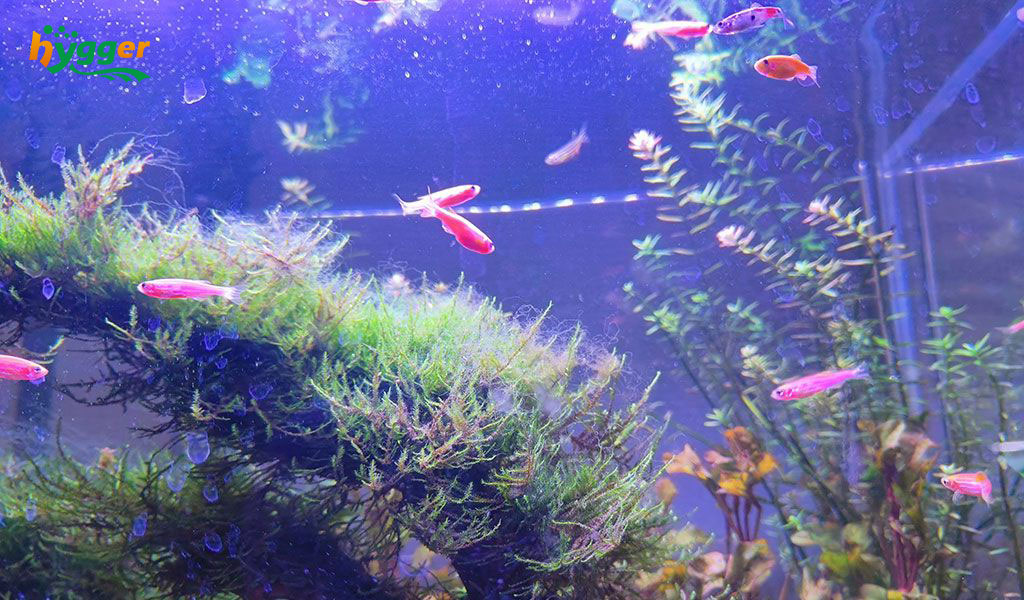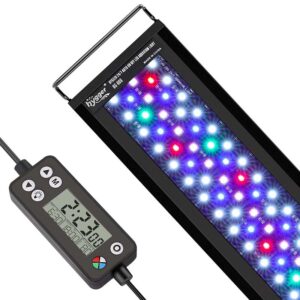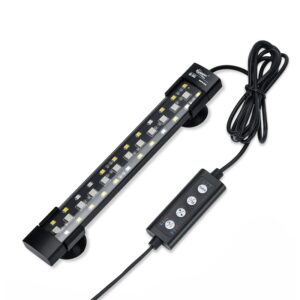Aquarium Lighting Basics Part Five
-Lighting color you should know
Hey, dear friends! We have mentioned something about light settings for aquariums in previous blogs. But do you know what light color is best for the growth of fish, plants, or algae? If the answer is negative, just read on. In today’s article, we are going to talk about light colors for your aquariums. You will walk away with a much better understanding of light color settings in tanks.
Color light do fish not like
Fish have poor color versions and they can not see all color spectrum that humans can see. They can see light with short wavelengths, like blue and green. However, they are unable to see light with long wavelengths, like orange and yellow. Also, most fish can not see UV light. In captivity, providing a proper light spectrum is critically crucial. White and blue lights are excellent options for both fish tanks and planted aquariums.
Furthermore, orange and yellow lights may not make sense in enhancing fish colors. Also, lights with lower intensity may be the same. By the way, aside from light, there are other factors. For example, genetics, diet, living conditions, etc.
However, no matter what light colors, never set prolonged and intense light. Otherwise, fish will not like it. And fish may feel stressed.
What color light is best for fish
To make fish brilliant and brighter, you can set the following light colors.
| Light colors | Light colors |
| Blue light | 1. Enhance fish color 2. Promote feeding behavior in some fish species 3. Be helpful to calcium absorption (e.g. shrimp, duckbill fish, corals) |
| Green light | 1. Attract fish 2. Reduce stress and aggression in some fish species |
| White light | 1. Attract fish 2. Enhance fish color |
| Red light | Make fish’s colors more vibrant (e.g. discus fish, blood parrots, red goldfish) |
Nonetheless, fish do not need light at night, they need time to rest. Commonly, the light you set for your fish tank should mimic the day and night cycle. Except for enhancing fish color, the light also enables fish to know the time (day and night).
Consequently, you’d better keep the light off at night. Besides, keeping the light on all day and night would cause stress on fish, while it also leads to algae thriving, making cloudy water and dirty aquarium. Once fish get stressed, they may become inactive and lose desire of appetite. Furthermore, if there are algae in your tank, reducing the light is necessary.

In short, the great light colors are blue, white, and red. The ideal light colors for freshwater tanks are a combination of red and blue light. And you should keep the light on for about 6–10 hours each day.
But for saltwater tanks, the combination of blue, red, and white light is a better choice. Blue lights are good for corals, shrimp, and fish. It makes sense to absorb calcium and strengthen health. On the other hand, red light plays a role in helping fish grow and forming bright colors. For saltwater reef tanks, you should keep the light on for 8–12 hours per day. Without plenty of light, corals may suffer death.
What color light helps plants grow
Proper light color for aquatic plants
Compared with fish, aquatic plants highly demand light spectrum. They need a specific range of light wavelengths to grow and bring out the colors. In planted aquariums, the best combination of light colors should be red, blue, and green.
| Light colors | Impacts on aquatic plants |
| Red light | 1. Be helpful to promote the production of chlorophyll and photosynthesize 2. Be crucial for flowering and fruiting |
| Blue light | 1. Be helpful to photosynthesize 2. Make the colors of plants’ leaves darker 3. Be good for stem growth |
| Green light | Maximizes plants’ exposure to light and makes sense for plant growth |
Other factors affecting plant growth
Additionally, light intensity and lighting time are other factors affecting the growth of aquatic plants.
Only with suitable light intensity, plants of red or chromatic colors can possess brilliant colors. On the other hand, except for chlorophyll, plants also contain other pigments, such as anthocyanin and carotene. If there is subdued light, the proportion of chlorophyll will be promoted. And it enhances photosynthesis efficiency. On the contrary, in the case of extremely intensive light, the chlorophyll would be damaged by too much light. Since then, the production of photopigments, such as carotenoids, will increase, which will lead to bright colors of leaves, red leaves, for instance.
Moreover, the same as fish, live plants also require time to rest. It is recommended to turn off your light at night. Then plants will stop photosynthesizing.

Light requirements of different aquatic plants
As the light requirements vary from diverse plant species. Given below are some references.
| Types of aquatic plants | Lighting hours | Light intensity | PAR values |
| Low light plants (e.g. Moss, Java fern, Anubias) |
8–10 hours | 10-20 lumens/liter | 15-30 PAR (10-50 μmol/s) |
| Medium-light plants (e.g. Red flame sword, Micro sword, Pearl weed) |
10 hours | 20-40 lumens/liter | 30-80 PAR (50-120 μmol/s) |
| High light plants (e.g. red or colored aquatic plants) |
10–12 hours | More than 40 lumens/liter | More than 80 PAR (120-200 μmol/s, or higher) |
What color light makes algae grow
As we have mentioned above, excess light will promote algae growth. So, what light color contributes to algae growth? A high blue and green light will result in algae thriving.
On the other side, though there is no specific light to completely stop algae thriving, warm light with lower intensity is helpful to limit or reduce algae growth. For example, orange and yellow light.
Additionally, if you want to limit algae growth in aquariums. Maintaining great water quality and keeping proper nutrient levels are critically crucial. Because poor water quality and excessive nutrients can be reasons for algae growth.
For more about aquarium algae or algae controlling in aquariums, you can go to:
Related topics about aquarium lighting
Finally, there is a summary of the best light colors for different tank types.
| Tank types | The best light colors |
| Freshwater tanks | red and blue |
| Saltwater tanks | blue, red, and white |
| Planted tanks | red, blue, and green |



Interesting. I just read a study from a group of university students in a lab setting experiment that was dealing with light and algae production. They were looking for light that increased algae growth for environmental use like scrubbing air and reducing carbon. They had postulated blue would be the best. However, they were only 1/2 right. The result showed clearly that white light generated the fastest and most algae growth (daylight type lights). Blue came in second. Red was lowest. While all light colors are important for production of plants and algae, I have read many sources that say red is for algae. It appears there are some controversies in light/algae growth. I repeatedly find article after article talking about blue being the “algae” light….that does not appear to be true. ALSO have read that red and green are best for algae, but research seems to dispute that….the green wavelength is reflected back so not as much ‘light’ is getting to the algae. Still waiting for a vetted PhD study on aquariums
I have a question about why my Trace inverter does not properly operate my Hygger HG-915 pump? Is it proper to ask that question here? I live in an area that has unreliable electric power supply.
Hi Raeburn Josey,
The HG-915-3000 DC water pump has an adapter that can be used with a wide voltage of 21-240V, and the minimum voltage of the 915 DC water pump is 21V, if your Trace Inverter voltage is 21V below when it runs, the pump’s motor can’t work well. If the Trace Inverter runs a voltage of 21V above always, then it can operate the pump well.
Thanks
hygger team